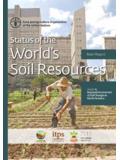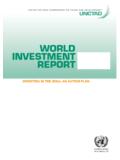Transcription of State of the World’s Forests - Home | Food and ...
1 State of the world s Forests Enhancing the socioeconomic benefits from Forests FAOS tate of theWorld s ForestsEnhancing the socioeconomic benefits from forests2014 Cover illustration: Elena Grossi Photos on divider pages: Chapter 1: Patrick Dugan, President of Bagong Pag-asa Foundation Incorporate, Philippines, and supporter of the implementation of the Assisted Natural Reforestation project, points out trees that have flourished thanks to the project. Chapter 2: Nakiru, from the Karamojong ethnic group of agro-pastoral herders living mainly in the north-east of Uganda, learns how to spell the words tree and table in her tribal language.
2 Chapter 3: Making furniture, Hanoi, Viet Nam. Chapter 4: High-rise housing seen from the elevated walkway of the forest Walk, Southern Ridges, Singapore. Chapter 5: Children planting trees, of the world s ForestsEnhancing the socioeconomic benefits from forestsFOOD AND AGRICULTURE ORGANIZATION OF THE UNITED NATIONSRome, 2014 ISSN 1020-5705 The designations employed and the presentation of material in this information product do not imply the expression of any opinion whatsoever on the part of the Food and Agriculture Organization of the United Nations (FAO) concerning the legal or development status of any country, territory, city or area or of its authorities, or concerning the delimitation of its frontiers or boundaries.
3 The mention of specific companies or products of manufacturers, whether or not these have been patented, does not imply that these have been endorsed or recommended by FAO in preference to others of a similar nature that are not 978-92-5-108269-0 (print)E-ISBN 978-92-5-108270-6 (PDF) FAO, 2014 FAO encourages the use, reproduction and dissemination of material in this information product. Except where otherwise indicated, material may be copied, downloaded and printed for private study, research and teaching purposes, or for use in non-commercial products or services, provided that appropriate acknowledgement of FAO as the source and copyright holder is given and that FAO s endorsement of users views, products or services is not implied in any requests for translation and adaptation rights, and for resale and other commercial use rights should be made via or addressed to information products are available on the FAO website ( )
4 And can be purchased through iiiContentsForeword viiAcknowledgements viiiAcronyms and abbreviations ixExecutive summary xiKey findings xiiiKey messages xiv1. Introduction 12. The measurement of socioeconomic benefits 5 Key message 6 The definition of socioeconomic benefits 6 Current measures of the socioeconomic benefits from Forests 7A proposed definition of the socioeconomic benefits from Forests 143.
5 The multiple benefits provided by Forests 17 Key findings 18 Income from forestry and forest -related activities 20 The numbers of people benefiting from income generation 25 Consumption benefits 29 The importance of forest benefits for specific groups 404. Policy measures to enhance forest -related benefits 47 Key messages 48 Securing and sustaining Forests benefits 49 Encouraging the provision of goods and services contributing to poverty reduction and the development of rural communities 50 Improving access to forest resources and markets to support livelihoods and income diversification 54 Creating enabling environments to encourage investment and related involvement of local and indigenous communities 59 Encouraging voluntary instruments as a means of developing and promoting forest products from sustainably managed Forests and improving
6 Market transparency 63 Promoting efficient production and processing of forest products, and related waste reduction and recycling 65 The designations employed and the presentation of material in this information product do not imply the expression of any opinion whatsoever on the part of the Food and Agriculture Organization of the United Nations (FAO) concerning the legal or development status of any country, territory, city or area or of its authorities, or concerning the delimitation of its frontiers or boundaries. The mention of specific companies or products of manufacturers, whether or not these have been patented, does not imply that these have been endorsed or recommended by FAO in preference to others of a similar nature that are not 978-92-5-108269-0 (print)E-ISBN 978-92-5-108270-6 (PDF) FAO, 2014 FAO encourages the use, reproduction and dissemination of material in this information product.
7 Except where otherwise indicated, material may be copied, downloaded and printed for private study, research and teaching purposes, or for use in non-commercial products or services, provided that appropriate acknowledgement of FAO as the source and copyright holder is given and that FAO s endorsement of users views, products or services is not implied in any requests for translation and adaptation rights, and for resale and other commercial use rights should be made via or addressed to information products are available on the FAO website ( ) and can be purchased through Promoting fair and equitable sharing of benefits from the utilization of traditional forest -related knowledge and practices 67 Recognizing the range of values derived from forest -related goods and services and reflecting them in the marketplace 695.
8 Strengthening the links between policies and benefits 75 Key findings and messages 76 Summary of the main socioeconomic benefits from Forests 77 Summary of the main policy developments since 2007 81 Opportunities to enhance the socioeconomic benefits from Forests 83 References 89 Annexes 93 Annex 1. Data sources used to assess the socioeconomic benefits from Forests 93 Annex 2.
9 Contribution of the formal forest sector to employment and GDP, 2011 100 Annex 3. Indicators of the socioeconomic benefits from Forests , 2011 108 Annex 4. Data sources used to obtain information on countries policy measures to enhance forest -related benefits 116 FiguresFigure 1: Hierarchy of needs that may be satisfied by the consumption of forest goods and services 15 Figure 2: Contribution of the forest sector to GDP in 2011 21 Figure 3: Income generated in the forest sector across the global population in 2011 21 Figure 4: Contribution of the forest sector to employment in 2011 26 Figure 5: Contribution of wood energy to TPES in 2011 33 Figure 6: Contribution of wood energy to TPES across the global population in 2011 33 Figure 7.
10 Proportion of households using woodfuel for cooking in 2011 35 Figure 8: Proportion of households where forest products are the main material used in house construction in 2011 36 Figure 9: Relationship between the contribution of the forest sector to GDP and per capita GDP in 2011 41 Figure 10: Relationship between the proportion of households cooking with wood in a country and per capita GDP in 2011 43 vBoxesBox 1: How many people live in or near Forests ? 12 Box 2: The impact of PES on forestry income 22 Box 3: Estimated impacts on human health of cooking with woodfuel in 2011 39 Box 4: Burkina Faso enhancing socioeconomic benefits from NWFPs 51 Box 5: Specific poverty reduction measures in national forest policies Nepal 52 Box 6: Public forest programmes creating jobs the US Collaborative forest Landscape Restoration Program 53 Box 7: forest land allocation in Viet Nam 55 Box 8: Amending forest concessions Brazil 56 Box 9: China forest Tenure Trade Centres and forest Farmer Cooperatives 58 Box 10.















